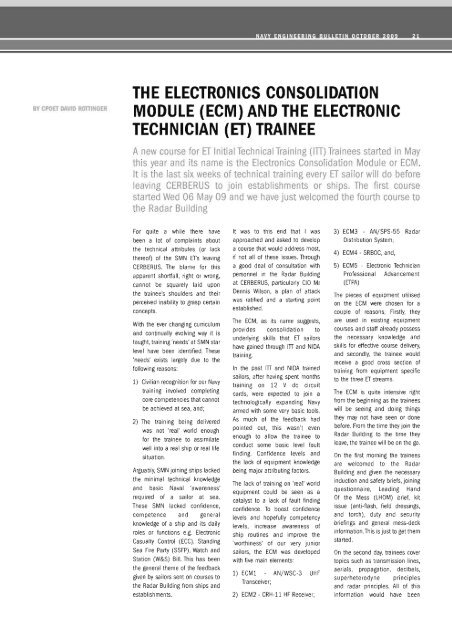ENGINE - Royal Australian Navy
ENGINE - Royal Australian Navy
ENGINE - Royal Australian Navy
You also want an ePaper? Increase the reach of your titles
YUMPU automatically turns print PDFs into web optimized ePapers that Google loves.
BY CPOET DAVID ROTTINGER<br />
THE ELECTRONICS CONSOLIDATION<br />
MODULE (ECM) AND THE ELECTRONIC<br />
TECHNICIAN (ET) TRAINEE<br />
A new course for IT Initial Technical Training (ITT) Trainees started in May<br />
this year and its name is the Electronics Consolidation Module or ECM.<br />
It is the last six weeks of technical training every IT sailor will do before<br />
leaving CERBERUS to join establishments or ships. The first course<br />
started Wed 06 May 09 and we have just welcomed the fourth course to<br />
the Radar Building<br />
For quite a while there have<br />
been a lot of complaints about<br />
the technical attributes (or lack<br />
thereof) of the SMN Er's leaving<br />
CERBERUS. The blame for this<br />
apparent shortfall, right or wrong,<br />
cannot be squarely laid upon<br />
the trainee's shoulders and their<br />
perceived inability to grasp certain<br />
concepts.<br />
With the ever changing curriculum<br />
and continually evolving way it is<br />
taught, training 'needs' at SMN star<br />
level have been identified. These<br />
'needs' exists largely due to the<br />
following reasons:<br />
1) Civilian recognition for our <strong>Navy</strong><br />
training involved completing<br />
core competencies that cannot<br />
be achieved at sea , and;<br />
2) The training being delivered<br />
was not 'real' world enough<br />
for the trainee to assimilate<br />
well into a real ship or real life<br />
situation.<br />
Arguably, SMN joining ships lacked<br />
the minimal technical knowledge<br />
and basic Naval 'awareness'<br />
required of a sailor at sea .<br />
These SMN lacked confidence,<br />
competence and genera l<br />
knowledge of a ship and its daily<br />
roles or functions e.g. Electronic<br />
Casua lty Control (ECC), Standing<br />
Sea Fire Party (SSFP), Watch and<br />
Station (W&S) Bill. This has been<br />
the general theme of the feedback<br />
given by sailors sent on courses to<br />
the Radar Building from ships and<br />
establishments.<br />
It was to this end that I was<br />
approached and asked to develop<br />
a course that would address most,<br />
if not all of these issues. Through<br />
a good deal of consultation with<br />
personnel in the Radar Building<br />
at CERBERUS, particularly CIO Mr<br />
Dennis Wilson, a plan of attack<br />
was ratified and a starting point<br />
established.<br />
The ECM, as its name suggests,<br />
provides consolidation to<br />
underlying skills that Er sailors<br />
have gained through lIT and NIDA<br />
train ing.<br />
In the past lIT and NIDA trained<br />
sailors, after having spent months<br />
training on 12 V dc circuit<br />
cards, were expected to join a<br />
technologica lly expanding <strong>Navy</strong><br />
armed with some very basic tools.<br />
As much of the feedback had<br />
pointed out, this wasn't even<br />
enough to allow the trainee to<br />
conduct some basic level fault<br />
finding. Confidence levels and<br />
the lack of equipment knowledge<br />
being major attributing factors.<br />
The lack of training on 'real' world<br />
equipment could be seen as a<br />
catalyst to a lack of fault finding<br />
confidence. To boost confidence<br />
levels and hopefully competency<br />
levels, increase awareness of<br />
ship routines and improve the<br />
'worthiness' of our very junior<br />
sailors, the ECM was developed<br />
with five main elements:<br />
1) ECM1 - AN/WSC-3 UHF<br />
Transceiver;<br />
2) ECM2 - CRH-ll HF Receiver;<br />
3) ECM3 - AN/SPS-55 Radar<br />
Distribution System;<br />
4) ECM4 - SRBOC, and,<br />
5) ECM5 - Electronic Technician<br />
Professional Advancement<br />
(ErPA)<br />
The pieces of equipment utilised<br />
on the ECM were chosen for a<br />
couple of reasons; Firstly, they<br />
are used in existing equipment<br />
courses and staff already possess<br />
the necessary knowledge and<br />
skills for effective course delivery,<br />
and secondly, the trainee would<br />
receive a good cross section of<br />
train ing from equipment specific<br />
to the three Er streams.<br />
The ECM is quite intensive right<br />
from the beginning as the trainees<br />
will be seeing and doing things<br />
they may not have seen or done<br />
before. From the time they join the<br />
Radar Building to the time they<br />
leave, the trainee will be on the go.<br />
On the first morn ing the tra inees<br />
are welcomed to the Radar<br />
Building and given the necessary<br />
induction and safety briefs, joining<br />
questionnaire, Leading Hand<br />
Of the Mess (LHOM) brief, kit<br />
issue (anti-flash , fie ld dressings,<br />
and torch), duty and security<br />
briefings and general mess-deck<br />
information. This is just to get them<br />
started.<br />
On the second day, trainees cover<br />
topics such as transmission lines,<br />
aeria ls, propagation, decibels,<br />
superheterodyne principles<br />
and radar principles. All of this<br />
information would have been

















